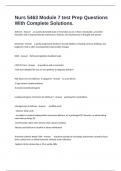Nurs 5463 Module 7 test Prep Questions
With Complete Solutions.
delirium - Answer an acutely disturbed state of mind that occurs in fever, intoxication, and other
disorders and is characterized by restlessness, illusions, and incoherence of thought and speech.
Dementia - Answer a slowly progressive decline in mental abilities, including memory, thinking, and
judgment, that is often accompanied by personality changes
RASS - Answer Richmond Agitation Sedation Scale
CAM ICU test - Answer -4 questions and a command
-Only tool validated for use on vent patients to diagnose delirium
Risk factors for ICU delirium. 3 categories - Answer 1) acute illness
2) age/chronic health problems
3) environmental/iatrogenic
Leading iatrogenic risk factors for delirium? - Answer psychoactive medications
Management of delirium - Answer - mobilize early
- improve sleep cycle
- no haldol or atypical antipsychotics to prevent dilirium, or is prolonged QT, Torsades, or when taking
meds that prolongs QT
-Use Precedex rather than benzos when require sedation
-Benzos and delirium in alcohol or benzo withdrawal
Transient Ischemic Attack (TIA) - Answer - transient episode of neurologic dysfunction caused by focal
brain, spinal cord, or retinal ischemia, without acute infarction
-highest risk for stroke after a TIA is within 48hr
,-15% of TIA precede stroke
-early intervention of TIA reduce risk for stroke-80%
TIA common and uncommon causes. - Answer common: atherosclerosis of large vessels,
cardioembolism and a-fib
uncommon: hypercoaguable states, aortic dissection, hyperlipidemia, smoking, obesity and DM
ABCD2 Risk Stratification Score - Answer -used by clinicians to determine risk of stroke in the first 7
days following a TIA
-5 parameters: age, BP, clinical features, duration of TIA, DM
-Score range 0-7
Management of TIA - Answer Use ABCD score to determine risk of CVA. If 3 or greater, should be
admitted
-Age (>60)
-Blood pressure (>140/90)
-Clinical symptoms
-Duration (>60 minutes)
-Diabetes
Treatment of TIA - Answer -tPA initiated if symptoms do not resolve and r/o bleed
-prophylactic antiplatelet therapy (if TIA is NOT caridogenic); ASA, ticlopidine (ticlid), clopidogrel (Plavix),
dipyridamole
-cardiogenic TIA requires anticoagulation
-IV heparin and then warfarin longterm
-carotid endarterectomy indicated in pts with ant circulation TIA and moderate-to-high grade carotid
stenosis (70-90%)
-control BP, (treat 220/120 or map >110) with CCB Nicardipine; mixed a1/b1,2 blocker Labetalol (it
decreases PVR w/o significant decrease in HR or CO
-serum cholesterol, glucose, afib, stop smoking, avoid excessive alcohol, lose weight
, Modifiable risk factors for stroke - Answer *Hypertension-most significant
Hypercholesterolemia
Atherosclerosis
Atrial fibrillation
Obesity
Drugs and alcohol
Diabetes, sickle cell anemia
TIA's
Non-modifiable risk factors for stroke - Answer a-fib
heart failure
cardiomyopathy
valve disorders
age,
gender,
race,
heredity
What is hemianopia/hemianopsia? - Answer vision loss (1/2 of visual field) in one or both eyes
What is transient monocular blindness? - Answer loss of vision in one eye 2nd to decreased bf in retinal
circulation
Aphasia - Answer impairment of language, usually caused by left hemisphere damage either to Broca's
area (impairing speaking) or to Wernicke's area (impairing understanding).
What does the anterior cerebral circulation supply blood too? - Answer The internal carotid, middle
anterior cerebral arteries supply blood to the frontal, parietal, temporal lobes, basal ganglia, thalamus,
hypothalamus




